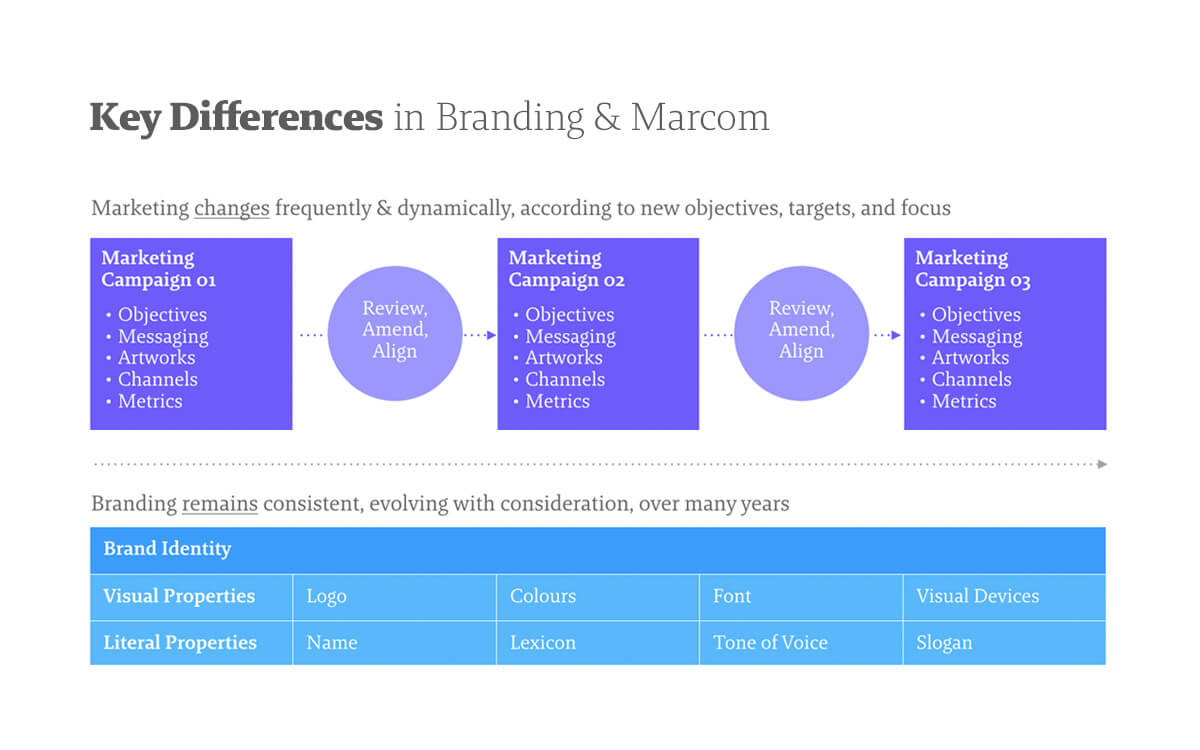The Difference Between Marcom & Branding Explained.

Even though branding and marcom differences could not be more stark, many people are still confused as to the what they are. In this blog we try and help people to understand the differences, the work each has to do and some key watch words to focus on when differentiating between them.
How confusing are the key branding and marcom differences?
Many people in the Middle East still think branding is the stuff ”you put on things’ and that marketing is ”the stuff you do to sell things. So let’s establish key terminology first. Branding is a strategic framework to direct a business towards intended goals and is expressed through its identity, both visually and literally (using logo and messaging plus other means). Marketing is the understanding of what products people want to buy from you and what price they are willing to pay for them (its offers). Brands use marketing communications (aka ‘marcom’) to express its offers to its audience through advertising.
The reason for this blog came about as we were working with a large regional bank recently and they had many issues with their marcom and brand relationship; one was overly dominant. They were suffering from the overpowering presence of the brand element we called ‘The Red Beast’. It was over everything, forcing the marketing communication (or ‘marcom’) to hide behind it and all the other visual devices the brand was using to identify itself. The existing visual template was a sea of red; the logo was huge and each product had its own identity too. It was a fight for space and brand was winning – “but what’s wrong with that”, you might ask? Well quite a bit as we will see in this blog.
Another issue was the amount of sub brand identities the brand featured. On every bit of marcom a product logo also had to be applied. “What is wrong with this you ask?” again… Well a few things, but mostly the fact that products (for the most part) don’t need logos. They are a waste of space and cause inefficiencies and marketing control issues. People buy products but they choose them based on an affinity with a brand. Great marketing is about building a brand’s equity over time. Equity is stored in a brand. Products come and go. If you build equity in a product it will die as the product line dies and products die sooner than brands. In fact 4/5 new brands die with in 2 years of birth.
The work of marketing communications
The key branding and marcom differences are inherent in their reasons for being; the work they have to do is fundamentally different. Marketing exists to excite customers with the prospect of a better life if they purchase the products offered. Marcom uses various tricks to achieve this and, once played, these tricks have reduced efficacy. Marcom has a half life of around two weeks; if the marketeer uses the same campaign over and over it becomes less effective, turning to ‘wallpaper’ in a little over 6 weeks. For marcom to be effective it has to be have newness or novelty.

Nike’s branding needs around 3% of this advert to stamp its ownership on its communication. The rest of the media can be novel content. Its novelty that attracts consumers.
Marcom is novelty, branding is ownership; let each do its thing unhindered.
Spotting Novelty
The human brain is hard wired to spot novelty; our brains crave it. Every new experience releases a little hit of dopamine into the brain. This is why technologies like TV, smartphones and social media are so addictive. Dopamine is a pleasurable experience. This dopamine effect probably evolved as part of our survival apparatus: our species needed to spot differences across the African savanna and respond accordingly. The differences could be prey or predator and our early ancestors would want to be aware of both quickly.
Novelty isn’t useful to a marketeer, it’s essential. Novelty attracts attention, creates excitement and releases dopamine. Mmm. Leading brands understand this and provide plenty of space for novelty in their marcom. Brands like Nike use over 90% of the available space for their novel marketing and the remainder for the brand.
Nike really understands the difference between branding and marcom and uses both to killer effect. It’s adverts are a wide open window onto the product while it’s minimal use of branding (tick, font and ‘authentically athletic’ tonality) elevates the brand and projects confidence.
The Work of Branding and Identity
Other key branding and marcom differences are about ownership. If marcom is all about attraction and novelty, branding is all about ownership and consistency. Where as marketing changes campaign-to-campaign, buffeted by the winds of change as it seeks to maintain its grip on fleeting attentions, branding is the steady tiller, setting the direction and relentlessly manoeuvring the good ship towards its stated vision. The key branding and marcom differences then are novelty or change; marcom has to do it often, branding should do it rarely. If marketing is a monthly revolution, branding is a decade-long evolution.
The other key branding and marcom differences is ownership. In your product’s marketing communication, the brand identification needs to state ownership and nothing else. The world’s most valuable companies know their marcom needs minimal branding. The brand’s presences informs viewers that the communication is brought to them by the company identified and by no other. As a well-designed campaign excites the attention of its audience, the branding simply has to remind the excited customer of whom this product is being sold by. A well designed brand can do this with no more than a simple swoosh or a bitten Apple.
So next time you’re reviewing your marcom consider these few points and you won’t go far wrong:
- Is the marcom attractive and novel
- Does the marcom have as much room as possible to attract and hold attention
- Is the brand identity (literal and visual) and tone of voice consistent and applied correctly
- Is the branding featured clearly and prominently but without interfering with the marcom
- Is the marcom building equity in the brand or product
Unisono works with leading brands across the globe. We help them with a range of branding initiatives and services from across the branding spectrum.
Branding Services:
- Audit – what are you doing well, what are your challenges ares? The brand audit reveals all.
- Strategy – the framework for building your long term brand value and equity.
- Visual Identity – how you look, from logo and typography, to colours and photographic palettes.
- Literal Identity – how you express who you are, the slogan, messaging platform and key messages your audience needs to read.
- Roll out – how are plan the delivery of the brand or rebrand into the market place.
- Management – how we ensure the brand is consistently applied and impact is maintained (and not weakened) over time.
- Communication – how you communicate to your target audience on at the brand (not marketing or advertising) level.

Time and temporality are defining differences; marcom is ephemeral where as branding is enduring.

